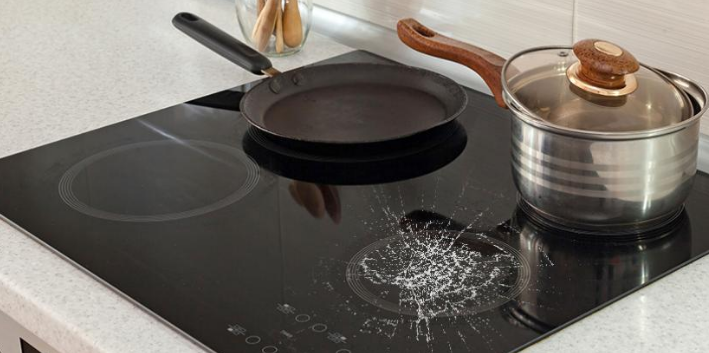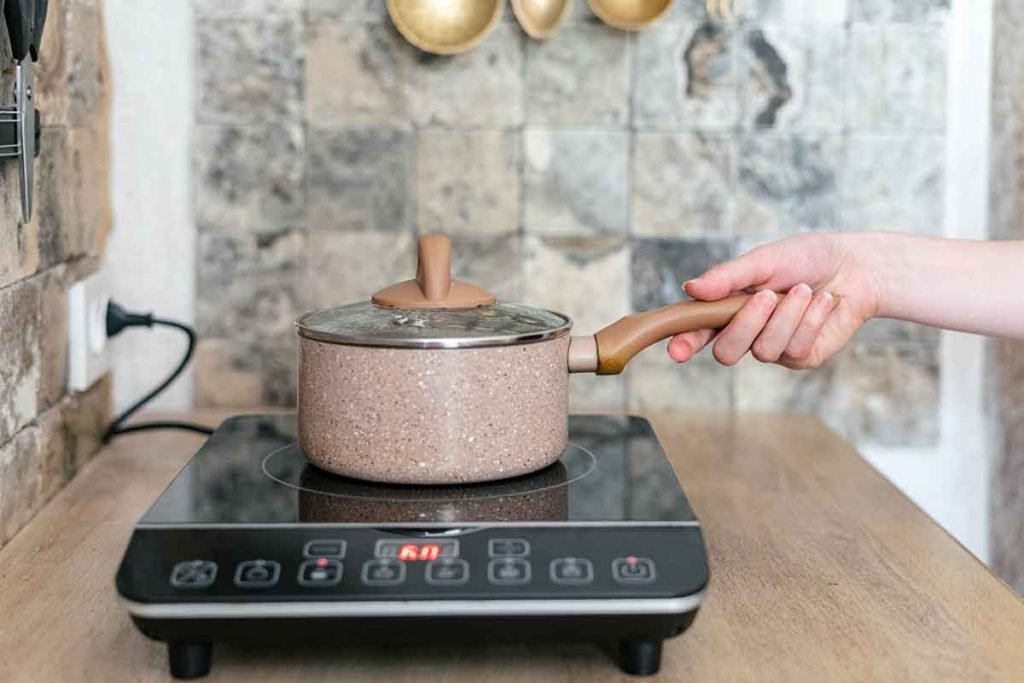Glass induction cooktops are stylish and elegant. They facilitate even heat distribution and make cooking a breeze. Sadly, these items don’t last forever. Since they are made of glass, induction cooktops are prone to cracking.
A cracked induction stop is unsafe because it exposes you to electrocution and higher risks of kitchen fires. So, if your stovetop has cracks, replace it immediately. Read on to learn how to fix a cracked induction cooktop. Our article will also introduce you to common causes of cracking in glass induction cooktops.
Let’s dive in.
Why did My Induction Hob Crack?
An induction hob can crack for the following reasons:
1. Sudden Impact
Induction glass cooktops are often extremely brittle. So, if you drop cookware on them, they will likely crap, especially if the dropped item lands on its edge. Tins, jars, bowls, mugs, or other significantly heavy objects falling from your kitchen shelves might also lead to a cracked glass stove top.
2. Thermal Shock
Suppose you take out a casserole dish from your oven and place it on your induction cooktop while it’s off. In that case, the extremely contrasting temperatures between the cookware and the cold glass top will cause thermal shock, one of the culprits that can cause cracking in your induction hob.
3. Poorly-made Cookware
Induction-friendly cookware should have a magnetic base. Most importantly, it should have a flat bottom that enables it to fully contact the induction hob’s heating element. Improperly-made cookware with rough or uneven edges can scratch your induction cooktop’s surface, weaken it, and make the glass more susceptible to cracking.
4. Low-quality Stovetop Glass
Quality induction cooktops are made from recommended materials like glass ceramic. This material is the most preferred since it can withstand over 1000 °C. It also has low thermal expansion and optimum heat distribution. On the other hand, other materials, including untreated glass, can’t withstand extreme temperatures. So, if your induction stove top glass cracked prematurely, you’ve enough reason to suspect the material used to make it.
5. Uneven Heating
The other common cause of a cracked stove top glass surface is uneven heating. Your induction cooktop can heat unevenly for several reasons, especially when using the wrong cookware. If this becomes too frequent, eventually, it will encourage the formation of stress points and cracks on the glass stove top.
6. Abrasive Cleaning Methods
The wrong tools and cleaning supplies can damage your induction cooktop. Take a metal scraper as an example. If you use this object to aggressively clean off stubborn stains, chances are high that it will leave scratches on the cooktop. With time, the scratches will multiply, compromise the appliance’s integrity, and encourage disastrous cracks.
7. Deterioration
If you ask around, you’ll encounter at least one person whose glass stove top cracked without warning after many years of use. And that shouldn’t be a cause for alarm since, like other materials, glass deteriorates over time. With regular use, a glass stove top wears out, weakens, and becomes more susceptible to cracking.
8. Cold Water
If you pour cold water on hot glass, it will crack and break. The same applies to a glass induction cooktop. Although these appliances remain relatively cool while cooking, don’t try to clean yours with cold water immediately after cooking. That is inadvisable because the contrasting temperatures between the hob and cold water can crack and damage the glass.
Can Induction Top Glass be Repaired?
Sadly, an induction top glass can’t be repaired. And you should never try to fix a cracked induction cooktop because the aftermath can be disastrous.
For instance, if you use regular glue to seal the crack on your induction hob, the crack will worsen when you start using the appliance again, eventually forcing the entire stove top to shatter. That is because regular adhesives can’t withstand extreme temperatures. Not to forget, heated glue can produce fumes that irritate the eyes, throat, and nose.
And don’t try to use epoxy. Although this substance can help you fix a cracked car windscreen, its magic will be lost on your glass stove top. This adhesive might seem effective but will leave a raised layer on your cooktop. To even out the layer, you must sand it down, exposing the glass to additional scratching and damage.
If you have a cracked glass stove top, the best thing to do is replace it or buy a new appliance.
How Can I Replace the Cracked Glass on My Cooktop?
If you’d like to replace a glass stove top, follow these steps:
Step 1: Safety First
Induction hobs rely on electricity, so the risk of getting electrocuted is 100% real. Plus, they often get hot, especially after cooking at high temperatures for extended periods. Before attempting to replace your appliance’s cooktop, ensure it’s unplugged. Better yet, turn off its power supply. And if you’ve used it recently, give the cooktop a few minutes to cool down.
Step 2: Get the Necessary Tools and Supplies
Replacing glass stops calls for a wide range of tools. These include a screwdriver for unscrewing the fasteners holding down the cracked cooktop and, of course, the replacement glass stove top. To be safer and avoid frequent trips to the store, get everything you might need in one haul, including work gloves, glass cleaner, scraper, etc.
Step 3: Remove the Cracked Glass Cooktop
Use a screwdriver to unfasten the screws holding your induction hob’s cooktop. Then, carefully lift the cracked cooktop and place it aside. Don’t try to forcefully pry the damaged glass from the hob because excessive force will shatter the already-fragile glass, causing a mess or injuries.
Depending on your appliance, you may disconnect different components, including heating elements and thermal sensors. If you deem this step necessary, take as many photos as you can at every step of the way. They’ll come in handy when you start reconnecting everything.
Step 4: Install the New Cooktop
Install the new cooktop after successfully removing the damaged component and cleaning the underlying surface if necessary. Do that carefully and ensure it’s connected to everything necessary. Then, secure the new cooktop with screws.
Step 5: Test Your Appliance
Testing your induction hob is crucial in ensuring the replacement is successful. Once you’ve secured the new glass cooktop, plug in your appliance, and turn it on. If it’s working, congratulations; you’ve done it! If not, check if you missed anything, like connecting the heating elements.
Replacing a cracked glass top is complicated and can put you in harm’s way. If you don’t have the skills and tools required to undertake this project, call in a technician who knows how to replace glass stove tops.
How Much Does a Glass Cooktop Replacement Cost?
Replacement glass tops for stove tops can be pricey. If you visit the market today, you’ll discover that most products cost between $300-$800. But that’s a pretty reasonable amount to spend, considering that the average cost of a new induction stove is $2,231.
If you decide to replace your cooktop glass, don’t prioritize cheapness. That is because most of the cheapest products are made of low-quality materials and, therefore, likely to damage again quickly. Ensure the item you choose to replace glass on cooktops with is reputable, made of durable material, and guaranteed to perform optimally.
How Can I Prevent My Induction Cooktop from Cracking?
Protecting your induction cooktop from cracking is. Just do the following:
- Don’t store heavy items like glass jars and canned food above your induction cooktop.
- Don’t drag cookware across your cooktop’s glass surface.
- Only use the recommended cookware to prepare food on your induction hob.
- Avoid using your cooktop’s glass surface as a chopping board
- Use specialized cooktop cleaners to wipe grease or stains off the induction hob’s glass surface
Are Some Brands More Prone to Cracking?
Some induction cooktop brands are more likely to crack than others because they are made of inferior glass. For instance, some manufacturers use tempered glass rather than high-quality ceramic glass, which is pricey. The former has inferior toughness, durability, and heat resistance and is likely to crack prematurely.
Before purchasing a replacement glass cooktop from a particular, check the material. Most importantly, review the brand’s online reputation to see if it sells quality products.
Final Thoughts
Several culprits can lead to cracking in induction cooktops. These include sudden impact from dropping objects like food cans, abrasive cleaning methods, and deterioration. You can protect your stove top from premature cracking in numerous ways, including storing heavy items far from the appliance and using the right cookware.
Most importantly, check the cooktop’s material before buying an induction hob. Prioritize buying appliances with quality materials like glass ceramic. Avoid cheaper alternatives such as tempered glass because they are more prone to cracking.
Frequently Asked Questions
Is it Safe to Use a Cracked Induction Cooker?
No, it is not. A cracked cooktop can expose electrical components and wiring, posing risks of electrical shocks, short circuits, and potential fire hazards.
What are the Dangers of Using a Cracked Induction Cooker?
Using a cracked induction cooker can expose you to electrical hazards, including the risk of electric shock. Additionally, a cracked surface can trap food particles, liquids, and moisture, further compromising the appliance’s safety and functionality.
Can a Cracked Induction Cooker be Repaired?
It is not advisable to repair a cracked induction cooker on your own, as it involves electrical components and potential safety risks. If your induction cooker is cracked, it’s best to consult the manufacturer or a qualified appliance repair professional to assess whether it can be safely repaired.
Can a Cracked Induction Cooker Cause a Fire?
A cracked induction cooker can potentially cause a fire if the exposed electrical components come into contact with liquids, leading to short circuits and sparks. This can create a dangerous situation in your kitchen.
Can Using a Cracked Induction Cooker Void the Warranty?
Using a cracked induction cooker, especially if it leads to further damage, could potentially void the warranty. It’s important to consult the manufacturer’s warranty terms and guidelines for more information.
What Should I Do if My Induction Cooker is Cracked?
If you discover that your induction cooker is cracked, you should stop using it immediately. Unplug the appliance and contact the manufacturer’s customer support or professional repair service for guidance on how to proceed.
Can I Continue Using the Induction Cooker if the Crack is Small?
Even if the crack seems small, it’s still not safe to continue using the induction cooker. Cracks can compromise the integrity of the appliance and create safety hazards.
How Can I Prevent Cracks in My Induction Cooker?
To prevent cracks, avoid placing heavy or sharp objects on the cooktop, be cautious when moving cookware on the surface, and avoid sudden temperature changes, such as placing hot cookware on a cold surface.



